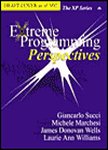版权所有:内蒙古大学图书馆 技术提供:维普资讯• 智图
内蒙古自治区呼和浩特市赛罕区大学西街235号 邮编: 010021

I S B N:(纸本) 9780201770056
出 版 社:Addison Wesley
出 版 年:2002年
主 题 词:Programming Methodology General Software Engineering
摘 要:From the Book: Welcome to yet another book on Extreme Programmingand Agile Methodologies, of course! Writing a book about new software development methodologies can be a very easy and a very difficult task together. It could be very easy, as you could talk about very generic and high-level vaporware without ever entering details, and backing your approach with statements such as it requires customization, no silver bullets, and other politically correct statements. You could take the completely opposite approach, and still have a fairly easy task if you have ever run a project with your methodology. You could enter a detailed description of what you did, distilling a complete approach around your individual idiosyncrasies. Best would be if you add something esoteric, such as typing into the keyboard with only the right hand, and using the left to hold a silk napkin with whom you would clean your sweater every other minute. This is not because software authors are bad by nature. We should remember that in the early days of the studies in electronics, the equation for the resistor was awfully complex, with lots of terms which were really insignificant. Nowadays, it is a simple algebraic division: R=V/I. However, writing about a new methodology becomes dreadfully difficult if you aim at creating something really valuable for the reader, combining the limited theoretical understanding with the limited experimental evidence, and avoiding a terse language. This book takes this latter approach. We combine an overview of XP, from the hand of the people who proposed it, description of experiences in specific areas yet unclear and subjectto debate, and an empirical evaluation of how XP projects are progressing in software companies. The first section is the overview of the methodology. We assume that you have already read the cult books, Kent s, Martin s, Ron s, Jim s, etc. So we summarize all the foundations in one chapter, by Don. In Chapter 2, Jim Highsmith presents the es